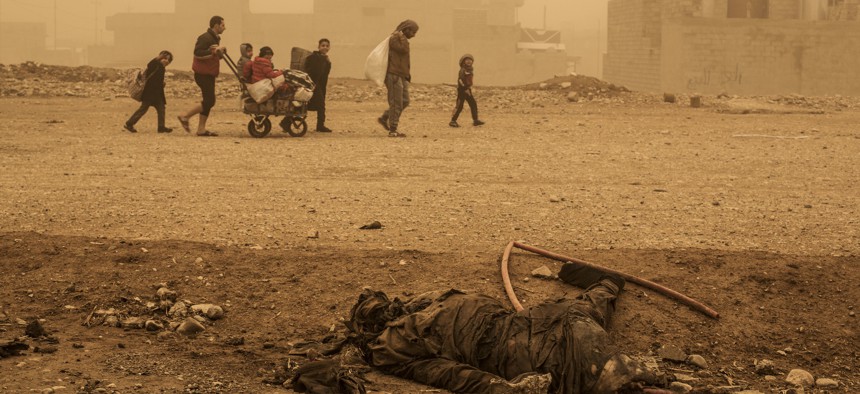
A group of civilians pass close to the body of an Islamic State militant, while fleeing from Mosul due to ISIS heavy shelling in several areas under control of the Iraqi Army, Mosul, Iraq, Friday, Dec. 2, 2016. AP Photo/Manu Brabo
Is ISIS More Violent During Ramadan?
The group has called for increased attacks during the Islamic holy month.
As Muslims observe Eid al-Fitr, the three-day festival marking the end of Ramadan, they celebrate the completion of a monthlong period of fasting, self-reflection, and spiritual renewal. It also marks the end of a holy month marred by several tragedies, from the attack in London that killed eight people to the blast that killed 17 people at an ice cream shop in Baghdad.
Such violence during Ramadan is not new. Previous Ramadans have witnessed a stunning rise in attacks relative to other months in recent years—an increase attributed, in part, to the Islamic State, and its attempts to transform the month of prayer and atonement to one of bloodshed and violence. Last year’s Ramadan, which took place between June 6 and July 5, was particularly deadly. In addition to a suicide-bombing in Baghdad, which resulted in the deaths of more than 200 people, ISIS also claimed deadly attacks in the U.S., Bangladesh, Lebanon, Turkey, and Saudi Arabia. In May of last year, by contrast, only one major attack attributed to ISIS outside of Iraq and Syria was recorded.
This Ramadan was no different. Within the first three weeks, ISIS claimed more than 300 attacks in at least 12 countries, according to SITE Intelligence Group, an organization that tracks terrorist groups online. Though some of the most high-profile of these attacks included the ISIS-linked takeover of Marawi City in the southern Philippines and the attack on the London Bridge, the vast majority of these incidents—approximately 80 percent, according to SITE— took place in Iraq and Syria, where ISIS faces accelerating offensives against its strongholds of Mosul and Raqqa. It’s a number that puts ISIS on track to meet, if not exceed, its level of violence from last year’s Ramadan, which witnessed nearly 400 attacks in at least 16 countries (the full data from this Ramadan is not yet available).
This spike in violence is no coincidence. ISIS has made a point of calling for increased attacks during Ramadan, often referring to the holiday as “the holy month of jihad.” In one audio message distributed using the encrypted messaging app Telegram, ISIS spokesman Abu al-Hassan al-Muhajir called on the group’s followers to target “the rejectionists and the apostates” in Iraq and Syria. He also urged them to target Iran, where the group claimed its first attack on the predominantly Shiite country on June 7 (ISIS subscribes to a militant version of Sunni Islam, and has often characterized Shiite Muslims as apostates). As Amarnath Amarasingam and Charlie Winter wrote in The Atlantic last month, the group points to early Islamic history to justify its aims:
To validate this position, jihadists often evoke the Battle of Badr, a key moment in early Muslim history that occurred during the month of Ramadan in the year 624 CE. During the battle, Muslim forces overwhelmed their enemies despite being massively outnumbered. Against all odds, their victory ensured the survival of the fledgling community of believers. It’s no surprise that jihadists like to draw attention to this example, manipulating it to their political ends.
But the scale of ISIS-related violence during Ramadan isn’t always consistent. As the University of Maryland's Global Terrorism Database noted in a 2015 report, the number of attacks carried out by core ISIS members (individuals who are considered operatives of the organization, as opposed to those belonging to ISIS-affiliated groups or individuals who are considered to be ISIS-inspired) increased each year during Ramadan between 2013 and 2015—in some cases only modestly—yet the number of attacks carried out by ISIS-affiliated groups decreased during 2014. Moreover, attacks by ISIS-inspired individuals decreased during Ramadan in 2014 and 2015. Over the longer term, after examining 10 years’ worth of attacks by ISIS and its precursor groups, the authors concluded: “While major attacks have taken place during Ramadan, we have also observed major attacks outside the month of Ramadan, and periods during which Ramadan was relatively calm. Thus, it remains an open question whether Ramadan is a period of heightened risk.”
Attacks not attributed to ISIS also saw a surge during Ramadan in 2013 and 2014. While the report notes that some of these attacks were committed by jihadists who may share ISIS’s ideological perspective, given the presence of non-jihadist groups in the data set, it also suggests that there could be a seasonal pattern of increased violence that has nothing to do with ideology (though the holiday’s dates vary as it follows the lunar calendar, the last several Ramadans have taken place over the summer). One such attack this year, during which a suspect drove a van into a crowd of worshippers near a mosque in London’s Finsbury Park neighborhood, was reportedly celebrated by white-supremacist organizations.
Though this lack of consistency makes it difficult to determine whether there’s indeed a causal link between Ramadan and heightened terrorism, the bloodshed is unlikely to let up once the month draws to a close. As ISIS continues to experience territorial losses in Iraq and Syria, some observers predict the group will accelerate calls for lone-wolf attacks overseas in an effort to prove to the world its enduring legitimacy.
NEXT STORY: The Danger of Yemen's Secret Prisons




